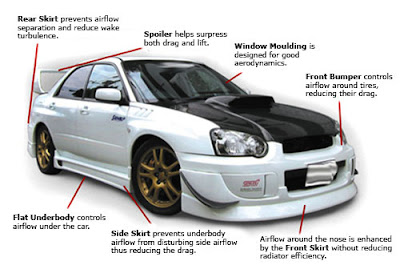Areas of modification
Car Audio
Is a term used to describe the sound or video system fitted in an automobile. A stock car audio system refers to one that was specified by the manufacturer when the car was built. A custom car audio installation can involve anything from the upgrade of the radio to a full-blown customization of a car based around its audio equipment. Events are held where entrants compete for the loudest or most innovative sound systems.
Interior tuning
Interior tuning is a term used for modifying of the the interior of a car. for example; removing the back seats to make room for a sound system, or taking out the front seats and replacing them with bucket seats (racing seats).
Another recent form of interior tuning is the replacement of an aftermarket version such as a cosmetic and/or for performance purposes.
Engine tuning
Engine tuning as of late has been marketed as the replacement of basic engine components with after-market versions that perform the exact same functions as those replaced while promising an increase in power output. Car tuners usually install new turbochargers, modify the car's engine cooling unit, replace the air filters but they could also install a more powerful engine on the cars they modify.
For example a tuner could modify the ECU to gain more power. Another example is the modification and/or replacement of the OEM manual transmission stick shift also known as a gear stick with an optimized aftermarket design known as a short shifter for further "fine" tuning the driver could include the fitting of a weighted shift knob which combines form, interior tuning, with function, further increasing performance.
Suspension tuning
Suspension tuning involves modifying the springs, shock absorbers, swaybars, and other related components of a vehicle. Shorter springs offer an improved lowered look and a lower center of gravity. Stiffer shock absorbers improve the dynamic weight shifting during cornering, and normally have shorter internals to stop them from bottoming out when shorter springs are used. Stiffer sway bars reduce body roll during cornering, thus improving the grip that the inside tires have on the surface; this improves handling response. Other components that are sometimes added are strut bars which improve the body stiffness, and help better maintain the proper suspension geometry during cornering. On some cars certain braces, anti-roll bars, etc, can be retro fitted to lower spec cars from sports models.
For offroad vehicles, the emphasis is on lengthening the suspension travel and larger tires to increase ground clearance.
Lowriders with hydraulic/pneumatic suspensions use another unique kind of suspension tuning in which the height of each individual wheel can be rapidly adjusted by system of rams, even to the extent that it is possible to "bounce" the wheels completely clear of the ground.
Body tuning
Body tuning involves adding or modifying spoilers and a body kit. Sometimes this is done to improve the aerodynamic performance of a vehicle, as in the case of some wings or bumper canards, or, to lighten the vehicle through replacing bodywork components such as hoods and rear view mirrors with components made from lighter composites such as CRFP. Cornering speeds and adhesion can be improved through the generation of downforce.
More often however, these modifications are done mainly to improve a vehicle's appearance, as in the case of non-functioning scoops, spoilers, wide arches or any aesthetic modification which offers no benefit to performance. Very rarely does an after market spoiler or body kit improve performance, the majority add weight and increase the drag coefficient of the vehicle and thus reduce its overall performance.
Increasing the wheel track width through spacers and wide body kits enhance the cars cornering ability. Lowering the center of gravity is another aim of body tuning dealt with via suspension modifications.
Terms
"Streeted" or "Tuner Cars" are Japanese imports, such as a Toyota Supra, Mazda RX-7, Subaru Impreza, and the Mitsubishi Lancer Evolution series. These cars are most commonly modified with the more expensive mods available. The most popular modifications include suspension upgrades, exhaust systems, and turbos.
Legal requirements
Many countries have legal requirements in regard to what car owners can and can't do in relation to vehicle modifications. For example, all vehicles in Victoria, Australia, must conform to construction standards to ensure vehicles provide drivers and passengers with a maximum level of safety.There are also restrictions for P Plate drivers which can prevent young drivers from driving modified vehicles.
In the United Kingdom and the Netherlands it is illegal for any car to have blue lights as they are used by the emergency vehicles.
In Scotland and Denmark, it is illegal for any car to have neon underlights on a car as it distracts other drivers. In the Netherlands neon is allowed under the car but only when the car is on display, if the car is on a public road the lights have to be switched off.
Recently, Belgium issued a new law which describes that bodykit parts need to be approved for safety issues.
-->









Thanks for Showing the best Modified Cars
ReplyDelete